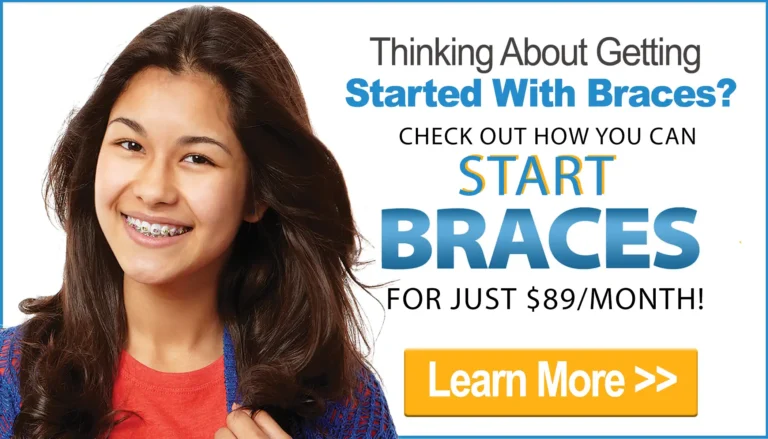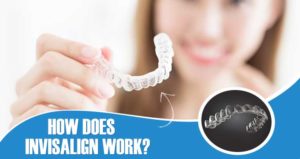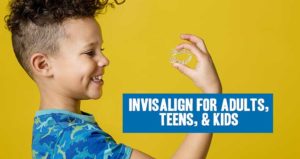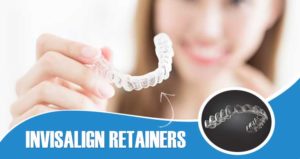Invisalign for Adults, Teens, and Kids

You’ve probably heard that Invisalign works for adults. But what may surprise you is that kids as young as 7 years old can also get Invisalign.
You’re probably thinking: Invisalign for kids? My kid won’t wear them. I definitely won’t be investing this kind of money on something my kid will just just take out or lose.
This may be true. Not every child, teen, or even adult is a perfect candidate for Invisalign. But you may be surprised just how many patients of all ages can and do get treated using Invisalign aligners.
This can sometimes be confusing, so keep reading for the facts.
Invisalign for Adults
Most adults wouldn’t mind looking younger. However, no one wants to go too far back in the time machine – and look like an awkward teenager again.

When it comes to braces, we probably all dread looking like the metal-mouthed, goofy kid we knew back in Junior High (or maybe you were that kid??). Metal braces can be uncomfortable and require significant maintenance.
If that’s how you feel, it’s okay! 🙂 You’re not alone…
That’s one of the major reasons why Invisalign was invented! Invisalign clear aligners are virtually invisible, providing a cosmetic benefit that appeals to many adults. Its lightweight and clear design lets adults avoid the metal mouth look of their past.
Invisalign, like braces before them, aren’t just for kids. Most adults CAN be treated with Invisalign and find great success. Below I’ll break down the benefits and potential drawbacks, of Invisalign for adults

Benefits of Invisalign for Adults
- They are (nearly) invisible.
- There are no dietary restrictions.
- Oral hygiene is easy. (brush and floss like normal)
- You can avoid the poking wires, cheek irritation, and other discomfort sometimes associated with braces.
- They can be removed during certain social situations or when taking pictures.
- They generally cause less soreness than braces.
- Fewer appointments are required. (fewer days of missed work or school)
- When you do have appointments, they are much shorter.
- Invisalign clear aligners are highly effective for various orthodontic issues.
- Treatment time can vary, but Invisalign often offers a shorter duration compared to traditional braces, depending on individual needs and the degree of correction.
Potential Drawbacks of Invisalign for Adults
- You have to be committed to wearing your aligners each day.
- Speaking while wearing Invisalign can be a little awkward for the first five to ten days. (Don’t worry, you get used to it much more quickly than braces)
- You need to remove the aligners when eating or drinking anything besides water. (This may disrupt your schedule a bit if you frequently snack or are a coffee drinker.)
- Certain tooth and bite problems may take longer to correct with Invisalign.
- Severe tooth and bite problems may be more difficult to treat while using Invisalign.
- Invisalign may not be suitable for all orthodontic issues, particularly complex cases that require more intensive treatment.
- As the treatment progresses, ongoing adjustments and changes to the aligners are necessary, which may include additional aligners and modifications during the final stages.
Most adults, after evaluating the benefits and potential drawbacks, agree that Invisalign is the best option for them.
Invisalign Teen
Many parents ask, “What is Invisalign Teen?”
Yes, it is a real thing.
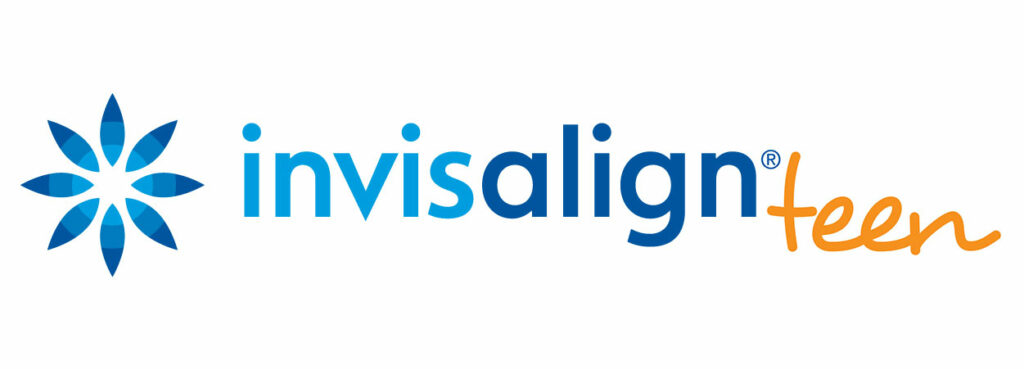
You may have heard about it, but most parents are a little unclear about how it differs from regular Invisalign…
So how is Invisalign Teen different from regular Invisalign?
Well… not by much. 🙂
However, at a younger age, the treatment process and eligibility criteria can differ due to the eruption of permanent teeth and the challenges of wearing removable trays.
For years most people have associated Invisalign treatment with adults and “Invisalign Teen” is Invisalign’s way of getting more orthodontic patients feeling comfortable with the idea of Invisalign for their teenager. (Most orthodontic patients are teenagers after all.)
So what are the differences between standard Invisalign vs. Invisalign Teen?
Invisalign Teen has “compliance indicators”. These are little blue dots that are placed on the Invisalign Teen aligners. When the aligner is worn the blue dot will fade away.
It’s essentially a way for parents to monitor their teenagers to make sure they’re wearing their aligners.

Invisalign Teen also comes with four free replacement aligners. This means that if your teenager happens to lose or misplace their aligners they can get up to four replacements at no cost.
Invisalign Teen allows for permanent teeth to grow in. This feature essentially allows a young patient, who may not have a full set of permanent teeth, yet to start Invisalign while their teeth are still growing in.
Besides these three features listed above, standard Invisalign and Invisalign Teen are virtually the same. All of the benefits and drawbacks listed about Invisalign for Adults would also apply to Invisalign Teen.
Based on our experience working with thousands of teenagers, we came up with a list of potential benefits and drawbacks of Invisalign Teen that are unique to a typical teenage lifestyle.

Benefits of Invisalign Teen
- They are easier for teenagers who play sports or play a musical instrument. Teenagers can play sports and instruments with braces, but Invisalign Teen definitely makes it easier.
- Teens that struggle with brushing and flossing will have fewer problems with Invisalign Teen.
- Teens that are self conscious about their appearance usually prefer Invisalign Teen.
- Fewer appointments are required which means you won’t need to miss school as often with Invisalign Teen.
- The appointments are shorter and much easier with Invisalign Teen, which is great for teens with sensory issues.
Potential Drawbacks of Invisalign Teen
- Your teen has to wear them. Not all teens, or even adults, are responsible enough for Invisalign treatment. However, we find that on average teenagers are MORE compliant than adults with their Invisalign Teen treatment! (Your teen may just surprise you.)
- Teens who lose their glasses, misplace their phone or keys may do the same with their Invisalign Teen aligners.
- Certain tooth and bite problems may take longer to correct with Invisalign Teen.
- Severe tooth and bite problems may be more difficult to treat while using Invisalign Teen.
If you or your teen are considering Invisalign Teen, it would be smart to review what is required and what responsibilities they are signing up for.
Compliance (meaning wearing the aligners 21 hours per day) is required for Invisalign to be an effective teeth-straightening tool…
We find that most teenagers who want Invisalign Teen are motivated enough to wear their aligners as instructed and will do what it takes to avoid braces.
About 95% of teenagers who start Invisalign Teen do great with it and don’t have a problem.
Those other 5%…
…usually due to lack of compliance…
…have to switch into braces in order to get their teeth or bite corrected. But, the good news is…
We are really good at braces too, so that’s not a problem! 🙂
Switching from Invisalign Teen to braces is really not too big of a deal and we are happy to do it when it’s required.
Invisalign First or Invisalign for Kids
After figuring out how to effectively treat adults and teenagers using Invisalign, the next logical step for the innovators of clear tooth alignment was to provide treatment options for kids ages 7 – 12.
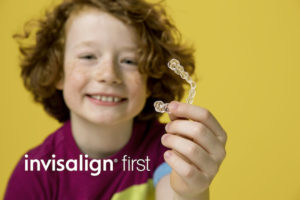
Most parents haven’t heard of, or seen, younger kids receiving Invisalign treatment, but it is a trend that is growing each year.
They call this specific type of treatment (Invisalign for kids 12 and under) Invisalign First and it is designed to perform Phase I orthodontic treatment.
More about this below…
What is Phase I Orthodontic Treatment?
Some children younger than 12 need an “early round” of orthodontic treatment. This is called Phase I treatment.
The goal of this first phase of treatment is to fix certain tooth and bite problems while they are still small to prevent them from turning into bigger problems when they are older.
Not all kids need Phase I treatment.
Only about 10% of the kids younger than 12 that come to our office need early treatment. For this 10%, starting early will help to save these kids (and you) from more costly, invasive and time-consuming treatments later in life.
Phase I treatment is different in that it doesn’t last too long (usually about 6-12 months).
The general game plan of Phase I orthodontic treatment goes like this:
- A child age 7 – 12 starts Phase I orthodontic treatment to correct certain tooth or bite problems that will get worse with age if untreated.
- A specific tooth or bite problem is corrected during Phase I while the child has a mix of permanent and baby teeth. The treatment usually lasts between 6-12 months.
- This child finishes Phase I treatment and will receive some form of retainer which they will wear as they lose their baby teeth.
- The child is evaluated once every 6 months by the orthodontist to monitor growth and development and loss of baby teeth.
- Usually around age 12 or 13, when the child is ready, they will begin Phase II orthodontic treatment. This is the final stage and will usually last 12 – 18 months.
- Once Phase II treatment is finished, the child will receive their final retainers and they will be finished with orthodontic treatment.
Phase I orthodontic treatment has traditionally been done with braces or other orthodontic appliance.
However, Invisalign has been innovating and developing their product, so we can now use it for Phase I treatment on younger kids. This version of their product that call “Invisalign First”.
Invisalign First is meant to treat Phase I patients in an orthodontic practice. While it still may not be able to work for every situation, Invisalign First can now be used to treat Phase I patients more than ever before.
The benefits and potential drawbacks of Invisalign First are as follows:

Benefits of Invisalign First
- Invisalign First eliminates broken brackets, poking wires, and other issues often associated with doing braces on young kids.
- Invisalign First eliminates the struggles with brushing and flossing that young kids tend to have with braces.
- Some of the big, bulky, and uncomfortable appliances used in Phase I orthodontics can be replaced with a much smaller more comfortable appliance. The Invisalign Mandibular Advancement appliance is one example.
- There is virtually no discomfort and the appointments are very short so young kids who are anxious about going to the dentist will generally do much better with Invisalign First.
- Younger children tend to be more cooperative and follow instructions even better than teenagers and do very well with Invisalign First.
Potential Drawbacks of Invisalign First
- Your child has to wear them. This is always the major obstacle of Invisalign treatment at any age. But, like we mentioned with Invisalign Teen, young children are often the most compliant and cooperative patients.
- Invisalign First can’t fix all tooth or bite problems in young kids. If your child needs Phase I treatment, Invisalign First may or may not be the right choice for your child. Make sure to discuss this option in detail with your orthodontist before making a final decision.
- We find most young kids in our practice still prefer braces. At least for now, young children are excited to wear braces, have colors on their teeth, and look forward to the experience.
In many situations braces or Invisalign First will work equally well to treat Phase I patients. If there is no major clinical benefit to one choice or the other, we let the parent and child decide the option that best fits their lifestyle.
For those that don’t want braces, Invisalign First is a great option.
Is Invisalign, Invisalign Teen, or Invisalign First the Best Choice for Me and My Kids?
If you’re still debating about whether braces or Invisalign is right for you, this may be a decision that is best made after an in-person consultation at our office.
There are times that a certain type of treatment is clearly the best choice…
…other times, either treatment option will work great, and it is purely a decision about which would best fit your lifestyle.
If you still have questions or would like us to evaluate your or your child’s teeth, you can schedule a free consultation for your or your child with Premier Orthodontics.
Now that you better understand the differences between Invisalign for Adults, Invisalign Teen, and Invisalign First, let’s discuss how long Invisalign takes to deliver healthy and perfect smile.
Click below to continue reading in Chapter 4.
Schedule a Free Invisalign Consultation For You or Your Child
You can schedule a 100% free consultation for Invisalign you or your child with Premier Orthodontics to find out if Invisalign is the best choice for you.
An initial exam and Invisalign consultation is 95% about getting your major questions and concerns answered directly from a professional, like:
![]() And any other questions you may have.
And any other questions you may have.

